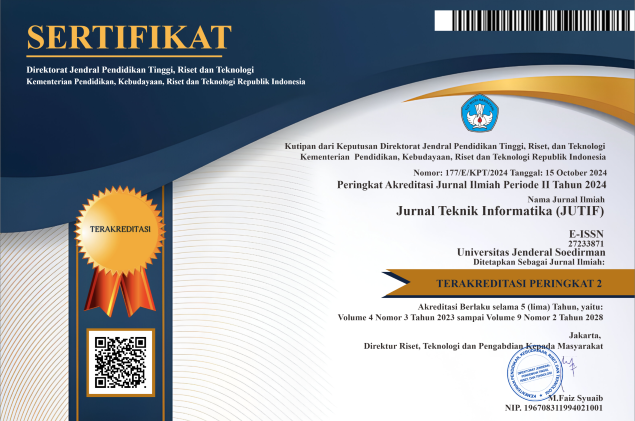Monkeypox Classification Using Convolutional Neural Networks (CNN) Pruned Residual Network-50 (ResNet-50) Architecture on Flutter Framework
DOI:
https://doi.org/10.52436/1.jutif.2025.6.4.5232Keywords:
CNN, Flutter, Monkeypox, Pruning, Quantization, ResNet-50Abstract
The monkeypox outbreak, which was previously only found in Africa, has now spread to other continents, including Asia, causing public concern as it occurred shortly after the COVID-19 pandemic was declared over. This disease has symptoms similar to cowpox, chickenpox, and measles, making early detection based on visual observation difficult. To address this issue, various studies have developed Deep Learning (DL)-based classification models using datasets such as WSI, MSID, MCSI, and MSLD v2, which are also utilized in this research. This study proposes a pruned ResNet-50 model using the Global MP method for pruning and QAT for quantization. These modifications not only maintain the model's performance with an accuracy of 94.44%, precision of 94.12%, recall of 94.71%, and F1-score of 94.16%, but also significantly reduce the model size to just 20.993 MB. As a result, the model can be implemented on Android devices with limited resources, enabling rapid and practical early detection of monkeypox in the field without requiring large-scale servers. Blackbox testing results show that the Flutter-based application utilizing this model performs well, potentially providing tangible support for medical personnel and the public in monitoring the spread of monkeypox in a more efficient and accessible manner.
Downloads
References
X. Peng et al., “Perceptions and worries about monkeypox, and attitudes towards monkeypox vaccination among medical workers in China: A cross-sectional survey,” J Infect Public Health, vol. 16, no. 3, 2023, doi: 10.1016/j.jiph.2023.01.010.
G. Kampf, “Efficacy of heat against the vaccinia virus, variola virus and monkeypox virus,” 2022. doi: 10.1016/j.jhin.2022.06.008.
Y. Şahin, H. Yüce, S. Ünüvar, and O. Çiftçi, “Current Pandemic in the World: Monkeypox from Past to Present,” An Acad Bras Cienc, vol. 95, no. 1, 2023, doi: 10.1590/0001-3765202320220767.
L. Budiyarto, A. A. Sabila, and H. C. Putri, “Infeksi Cacar Monyet (Monkeypox),” Jurnal Medika Hutama, vol. 4, no. 2, pp. 3225–3236, 2023, [Online]. Available: http://jurnalmedikahutama.com
S. Surati, H. Trivedi, B. Shrimali, C. Bhatt, and C. M. Travieso-González, “An Enhanced Diagnosis of Monkeypox Disease Using Deep Learning and a Novel Attention Model Senet on Diversified Dataset,” Multimodal Technologies and Interaction, vol. 7, no. 8, 2023, doi: 10.3390/mti7080075.
O. Mitjà et al., “Monkeypox,” The Lancet, vol. 401, no. 10370, pp. 60–74, Jan. 2023, doi: 10.1016/S0140-6736(22)02075-X.
R. Doshi, K. K. Hiran, R. K. Jain, and K. Lakhwani, Machine Learning: Master Supervised and Unsupervised Learning Algorithms with Real Examples, 1st ed. BPB Publications, 2022.
S. Dong, P. Wang, and K. Abbas, “A survey on deep learning and its applications,” Comput Sci Rev, vol. 40, 2021, doi: 10.1016/j.cosrev.2021.100379.
J. Zhang, X. Yu, X. Lei, and C. Wu, “A Novel Deep LeNet-5 Convolutional Neural Network Model for Image Recognition,” Computer Science and Information Systems, vol. 19, no. 3, 2022, doi: 10.2298/CSIS220120036Z.
N. Ketkar and J. Moolayil, Deep learning with python: Learn Best Practices of Deep Learning Models with PyTorch. 2021. doi: 10.1007/978-1-4842-5364-9.
A. Mumuni and F. Mumuni, “Data augmentation: A comprehensive survey of modern approaches,” 2022. doi: 10.1016/j.array.2022.100258.
R. L. Kumar, J. Kakarla, B. V. Isunuri, and M. Singh, “Multi-class brain tumor classification using residual network and global average pooling,” Multimed Tools Appl, vol. 80, no. 9, 2021, doi: 10.1007/s11042-020-10335-4.
S. A. Agrawal, V. D. Rewaskar, R. A. Agrawal, S. S. Chaudhari, Y. Patil, and N. S. Agrawal, “Advancements in NSFW Content Detection: A Comprehensive Review of ResNet-50 Based Approaches,” Original Research Paper International Journal of Intelligent Systems and Applications in Engineering IJISAE, vol. 11, no. 4, pp. 41–45, 2023, [Online]. Available: www.ijisae.org
E. H. I. Eliwa, A. M. El Koshiry, T. Abd El-Hafeez, and H. M. Farghaly, “Utilizing convolutional neural networks to classify monkeypox skin lesions,” Sci Rep, vol. 13, no. 1, 2023, doi: 10.1038/s41598-023-41545-z.
S. N. Ali et al., “A web-based mpox skin lesion detection system using state-of-the-art deep learning models considering racial diversity,” Biomed Signal Process Control, vol. 98, 2024, doi: 10.1016/j.bspc.2024.106742.
S. Saha, T. Chakraborty, R. Bin Sulaiman, and T. Paul, “A Comparative Analysis of CNN-Based Pretrained Models for the Detection and Prediction of Monkeypox,” arXiv:2302.10277, 2023.
L. Oneto, S. Ridella, and D. Anguita, “Do we really need a new theory to understand over-parameterization?,” Neurocomputing, vol. 543, 2023, doi: 10.1016/j.neucom.2023.126227.
S. Li et al., “Searching for Fast Model Families on Datacenter Accelerators,” in Proceedings of the IEEE Computer Society Conference on Computer Vision and Pattern Recognition, 2021. doi: 10.1109/CVPR46437.2021.00799.
A. M. Almars, “DeepGenMon: A Novel Framework for Monkeypox Classification Integrating Lightweight Attention-Based Deep Learning and a Genetic Algorithm,” Diagnostics, vol. 15, no. 2, Jan. 2025, doi: 10.3390/diagnostics15020130.
C. Morikawa et al., “Image and video processing on mobile devices: a survey,” Visual Computer, vol. 37, no. 12, 2021, doi: 10.1007/s00371-021-02200-8.
A. Tashildar, N. Shah, R. Gala, T. Giri, and P. Chavhan, “Application Development Using Flutter,” International Research Journal of Modernization in Engineering Technology and Science @International Research Journal of Modernization in Engineering, vol. 2, no. 8, 2020.
F. J. Dihan et al., “MpoxSLDNet: A Novel CNN Model for Detecting Monkeypox Lesions and Performance Comparison with Pre-trained Models,” arXiv:2405.21016v1, May 2024, [Online]. Available: http://arxiv.org/abs/2405.21016
Statista, “Number of smartphone users worldwide from 2014 to 2029,” Statista.com. Accessed: Oct. 25, 2024. [Online]. Available: https://www.statista.com/forecasts/1143723/smartphone-users-in-the-world
E. Windmill, Flutter in Action, 1st ed. Manning, 2019.
P. E. N. Taruno, G. S. Nugraha, R. Dwiyansaputra, and F. Bimantoro, “Monkeypox Classification based on Skin Images using CNN: EfficientNet-B0,” in E3S Web of Conferences, 2023. doi: 10.1051/e3sconf/202346502031.
T. Islam, M. A. Hussain, F. U. H. Chowdhury, and B. M. R. Islam, “A Web-scraped Skin Image Database of Monkeypox, Chickenpox, Smallpox, Cowpox, and Measles,” bioRxiv, 2022, doi: 10.1101/2022.08.01.502199.
D. Bala et al., “MonkeyNet: A robust deep convolutional neural network for monkeypox disease detection and classification,” Neural Networks, vol. 161, 2023, doi: 10.1016/j.neunet.2023.02.022.
M. G. Campana, M. Colussi, F. Delmastro, S. Mascetti, and E. Pagani, “A Transfer Learning and Explainable Solution to Detect mpox from Smartphones images,” Pervasive Mob Comput, vol. 98, 2024, doi: 10.1016/j.pmcj.2023.101874.
L. Zhang, Y. Bian, P. Jiang, and F. Zhang, “A Transfer Residual Neural Network Based on ResNet-50 for Detection of Steel Surface Defects,” Applied Sciences (Switzerland), vol. 13, no. 9, May 2023, doi: 10.3390/app13095260.
D. Valero-Carreras, J. Alcaraz, and M. Landete, “Comparing two SVM models through different metrics based on the confusion matrix,” Comput Oper Res, vol. 152, 2023, doi: 10.1016/j.cor.2022.106131.
J. Chong, M. Gupta, and L. Chen, “Resource Efficient Neural Networks Using Hessian Based Pruning,” Jun. 2023, [Online]. Available: http://arxiv.org/abs/2306.07030
M. Gupta et al., “Is Complexity Required for Neural Network Pruning? A Case Study on Global Magnitude Pruning,” ArXiv, Jan. 2024, [Online]. Available: http://arxiv.org/abs/2209.14624
L. A. Flowers, “Testing educational digital games,” Commun ACM, vol. 64, no. 9, pp. 38–40, Sep. 2021, doi: 10.1145/3450758.
J. Martin, Rapid application development, 3rd ed. New York : Macmillan Pub. Co. ; Toronto : Collier Macmillan Canada ; New York : Maxwell Macmillan International, 1991.
Additional Files
Published
How to Cite
Issue
Section
License
Copyright (c) 2025 Irfan Priatna, Ipung Permadi, Nofiyati

This work is licensed under a Creative Commons Attribution 4.0 International License.



























